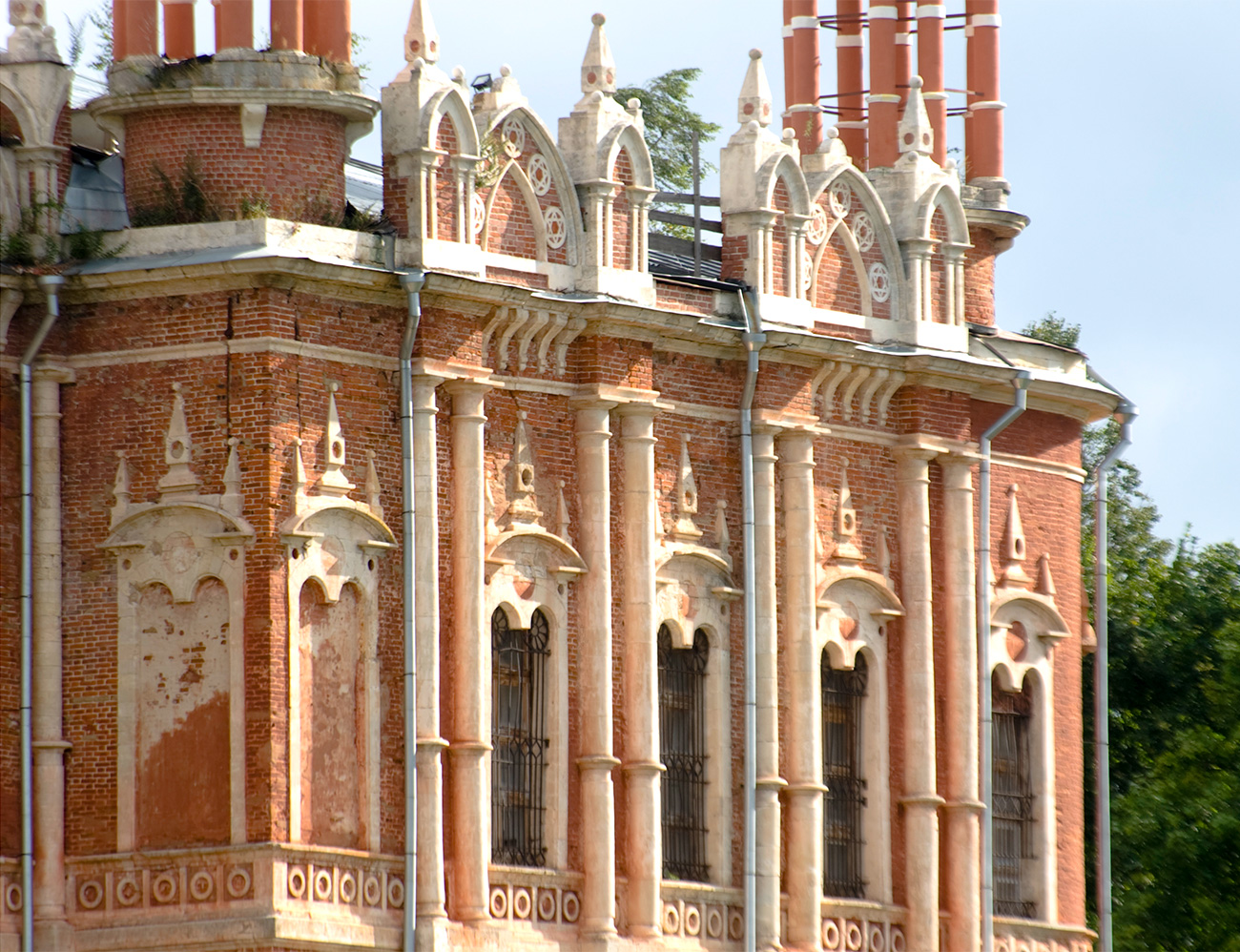 Mozhaisk. Cathedral of St. Nicholas, south facade. August 21, 2012. / Photo: William Brumfield
Mozhaisk. Cathedral of St. Nicholas, south facade. August 21, 2012. / Photo: William Brumfield
At the beginning of the 20th century, Russian chemist and photographer Sergei Prokudin-Gorsky invented a complex process for vivid, detailed color photography (see box text below). His vision of photography as a form of education and enlightenment was demonstrated with special clarity through his photographs of architectural monuments in the historic sites throughout the Russian heartland.
One such settlement is the small town of Mozhaisk, which Prokudin-Gorsky visited in the summer of 1911 as part of a project to document sites connected with the centennial of the Napoleonic invasion of Russia. He was particularly taken by the festively decorated St. Nicholas Cathedral, located at the town’s highest point. My own visits to Mozhaisk occurred between 1992 and 2014.
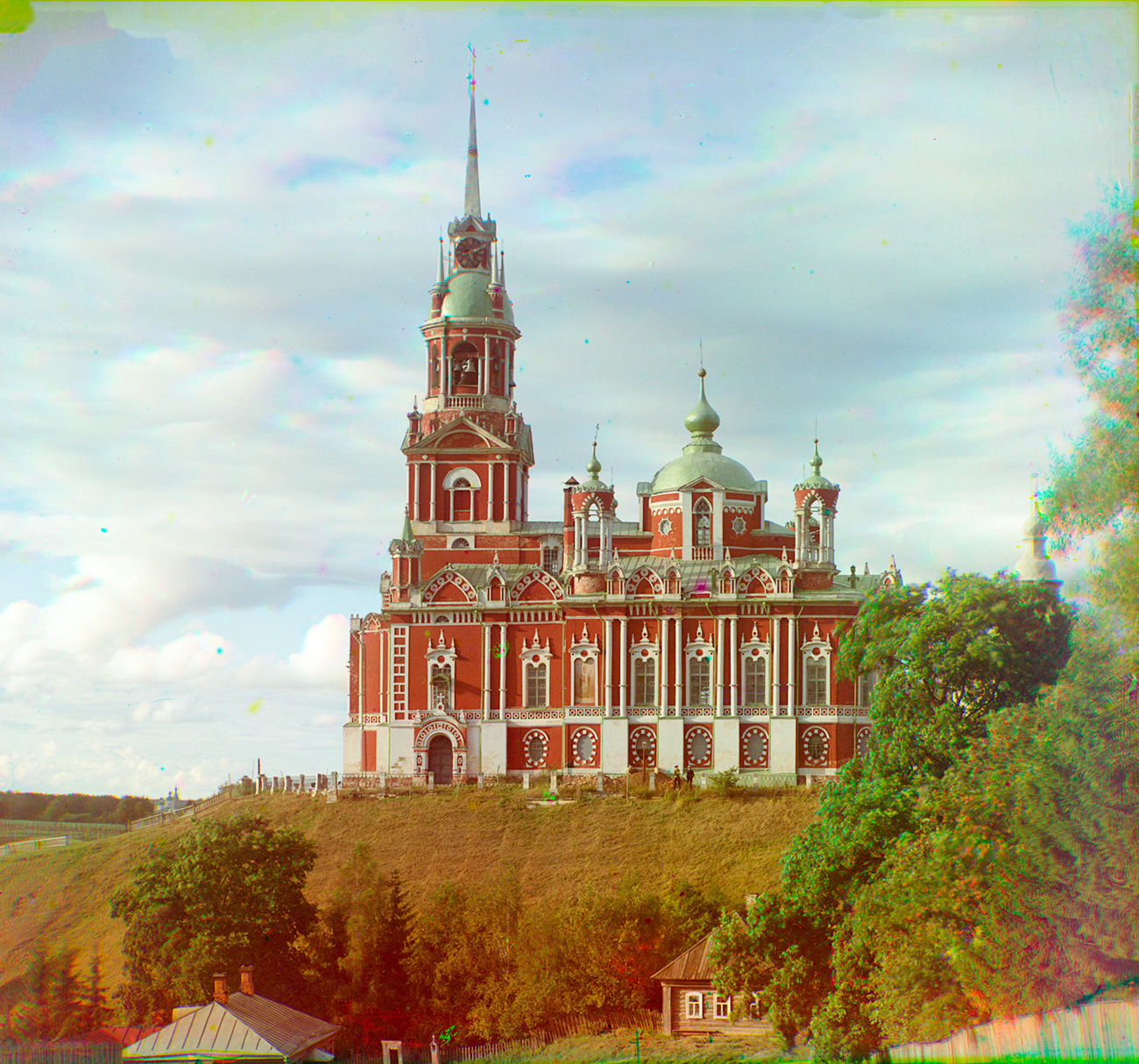 Cathedral of St. Nicholas, south view. Summer, 1911. / Photo: Sergei Prokudin-Gorsky
Cathedral of St. Nicholas, south view. Summer, 1911. / Photo: Sergei Prokudin-Gorsky
Mozhaisk is first mentioned in medieval chronicles under the year 1231, when it faced attacks both by the forces of Novgorod and those of Prince Yaroslav of Vladimir. Later that same decade, the town faced destruction during the Mongol invasion that dwarfed anything yet seen in medieval Rus. During this period, the settlement was a part of the Smolensk principality, to which it remained affiliated in various forms throughout the 13th century.
In 1303, Mozhaisk was seized by Moscow Prince Yury Danilovich, who used its fortress as a bulwark on Muscovy’s western borders. This strategy proved sound in 1341 and 1368, when Mozhaisk withstood attacks by Lithuanian Prince Olgerd as part of larger campaigns against Moscow.
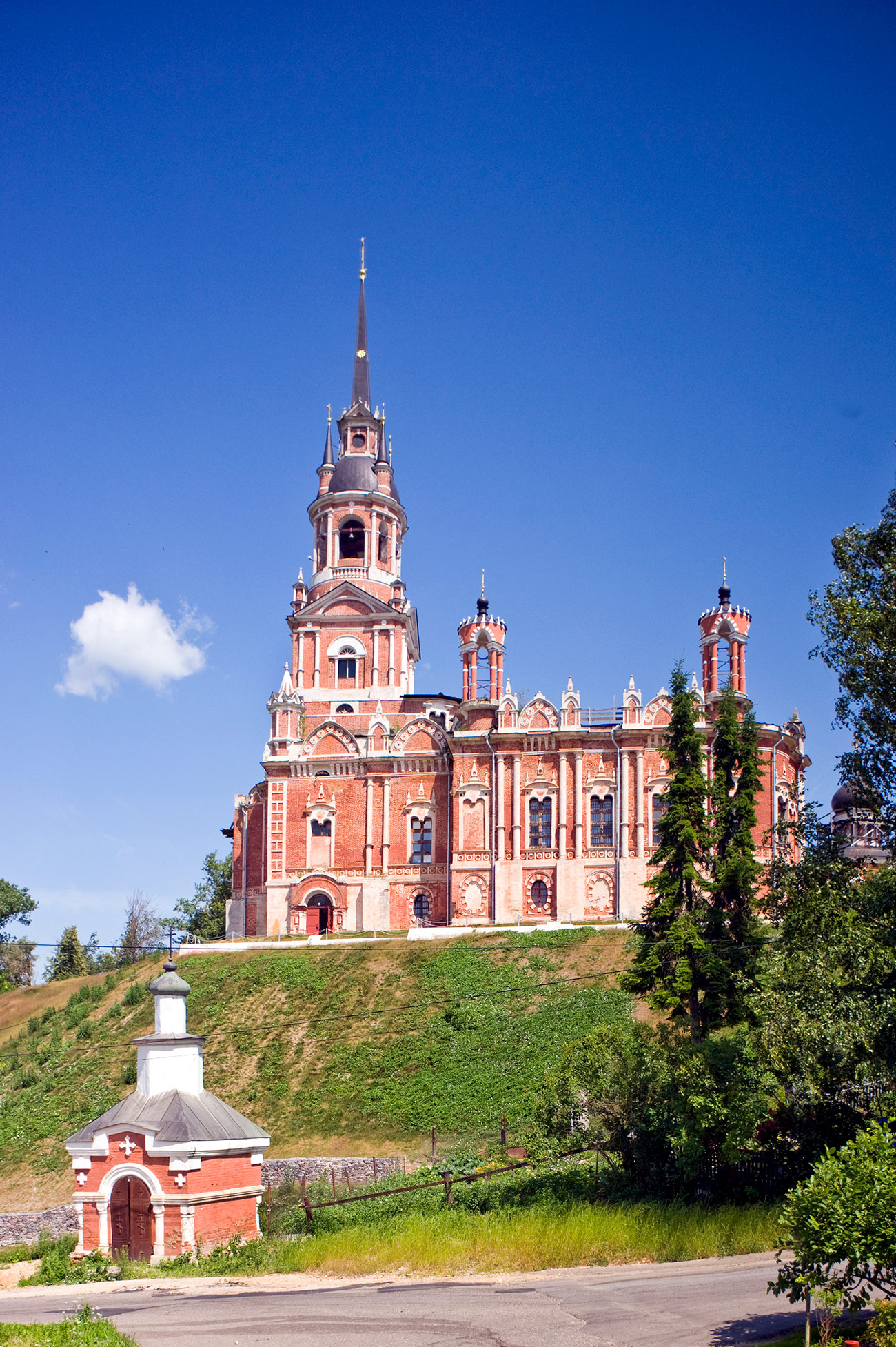 Cathedral of St. Nicholas. South view with Kremlin Chapel (built 1912). July 5, 2015. / Photo: William Brumfield
Cathedral of St. Nicholas. South view with Kremlin Chapel (built 1912). July 5, 2015. / Photo: William Brumfield
Mozhaisk was again devastated by Khan Tokhtamysh in 1382 during an invasion to reassert the authority of the Horde over Moscow’s Grand Prince Dmitry Donskoy, who had defeated the Tatar army of Khan Mamai near the Don River in 1380. This litany of devastation suggests that the fate of Mozhaisk was a reflection of the violent history of all medieval Muscovy.
From 1389 to 1493, Mozhaisk existed as a feudal principality subordinate to Moscow. In these years, the town became a destination for pilgrims drawn by an account of a miraculous appearance of St. Nicholas during one of the many attacks on the town. With upraised sword in hand, St. Nicholas is thought to have protected the besieged fortress, or kremlin. Thereafter, Mozhaisk became known for its miracle-working icon of St. Nicholas. The image was often reproduced as a painted wooden statue holding a sword in one hand and a representation of the citadel in the other.
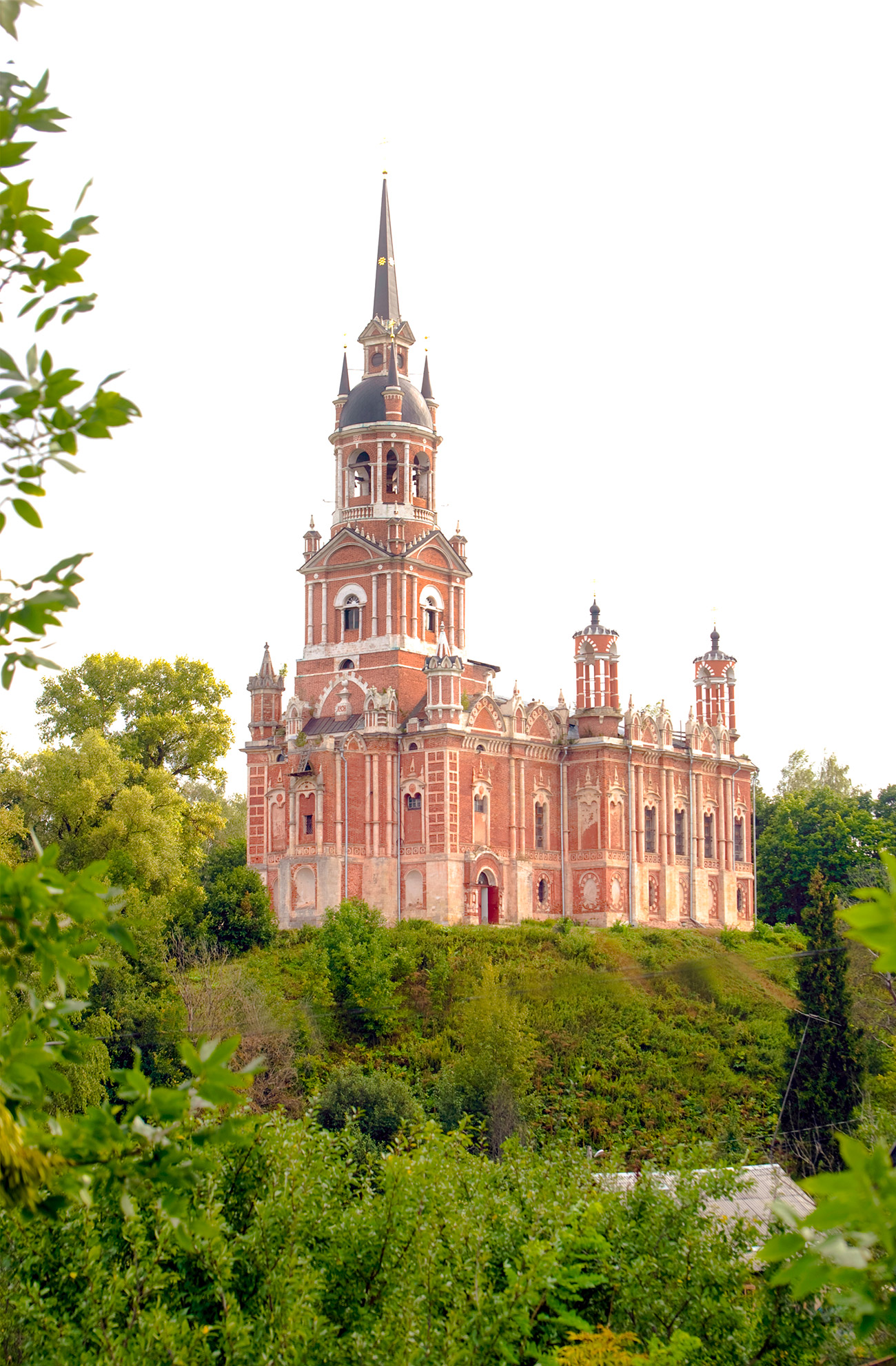 Cathedral of St. Nicholas, southwest view. Aug. 21, 2012. / Photo: William Brumfield
Cathedral of St. Nicholas, southwest view. Aug. 21, 2012. / Photo: William Brumfield
From the mid-16th century, the miraculous St. Nicholas icon was preserved in the Church of Elevation of the Cross, first built in the 1540s and rebuilt in 1624-26 above the St. Nicholas Gate, the main entrance to the fortress. In 1680-84, this church was rebuilt at the command of Patriarch Joachim of Moscow, who reconsecrated it in 1685 as the Church of St. Nicholas. (The Mozhaisk kremlin already had a small St. Nicholas Cathedral, built of limestone at the turn of the 15th century.)
With the kremlin no longer in use, a reconstruction of the St. Nicholas Church began in 1779 with the dismantling of the gate and an expansion of the limestone foundation. Construction of what became a new St. Nicholas Cathedral culminated in in the early 19th century with an exuberant pseudo-Gothic display, which Prokudin-Gorsky photographed in 1911. This new St.Nicholas Cathedral was designed by Aleksei N. Bakarev, a pupil of renowned architect Matvei Kazakov, who built much of the pseudo-Gothic fantasy at Moscow’s imperial Tsaritsyno estate. Napoleon’s troops sacked the still unfinished Mozhaisk cathedral on their way to Moscow in the fall of 1812. It was finally completed in 1814 with the main altar consecrated to St. Nicholas.
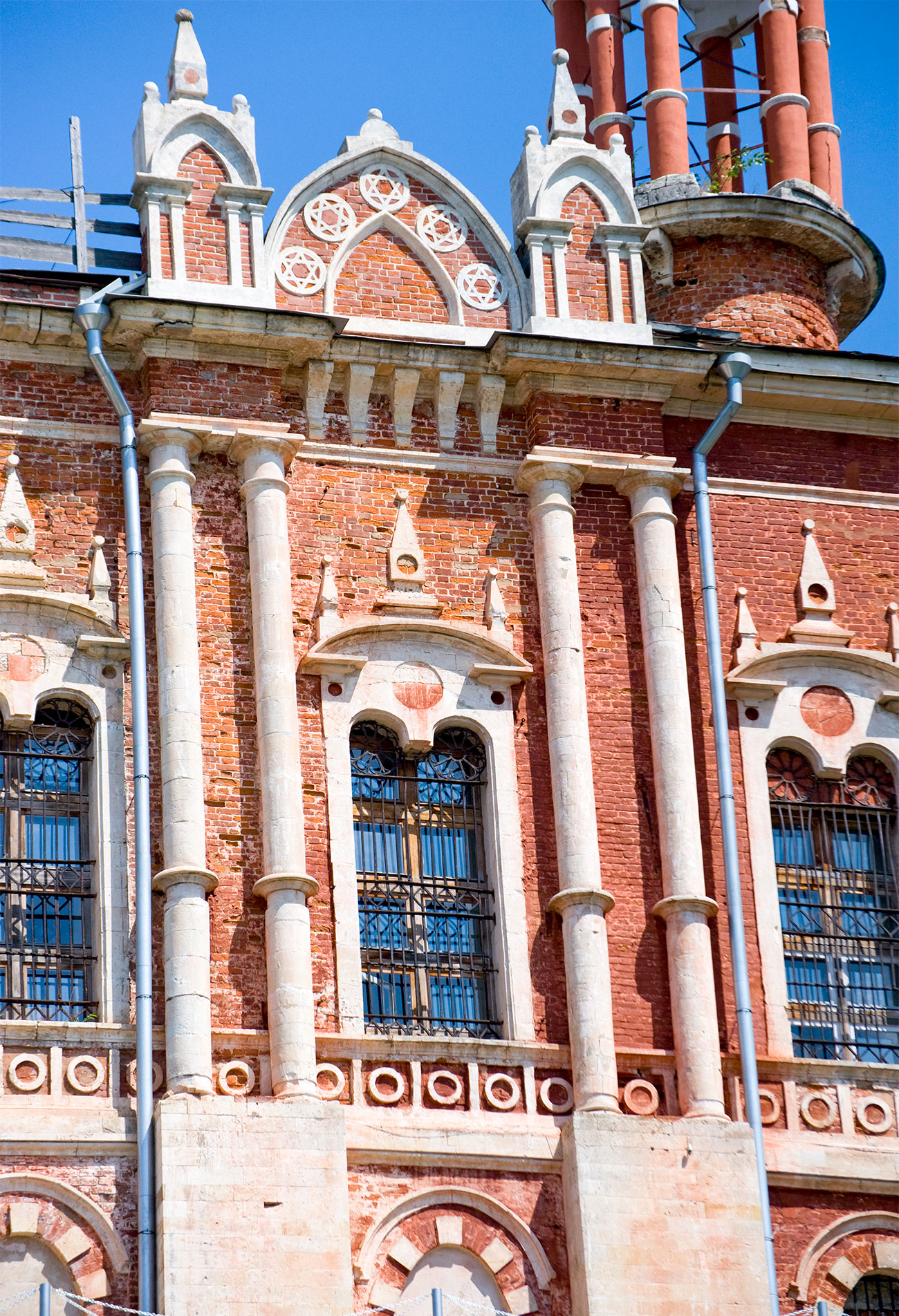 Cathedral of St. Nicholas, south facade, decorative details. July 5, 2015. / Photo: William Brumfield
Cathedral of St. Nicholas, south facade, decorative details. July 5, 2015. / Photo: William Brumfield
In appearance, the St. Nicholas Cathedral is quite unusual for a Russian Orthodox church. Its elongated form and tall windows suggest a medieval European style, as does the eccentric limestone decoration. The crown of the structure is also significantly different from the typical design. Instead of a large central cupola, the roof supported a small rotunda, which in 1829 gained its own altar, dedicated to the Mandylion Icon of the Savior. And in place of the typical four secondary cupolas, the corners of the roof were marked by four miniature towers reminiscent of fortress turrets. A bell tower with a tall spire adorned the west end.
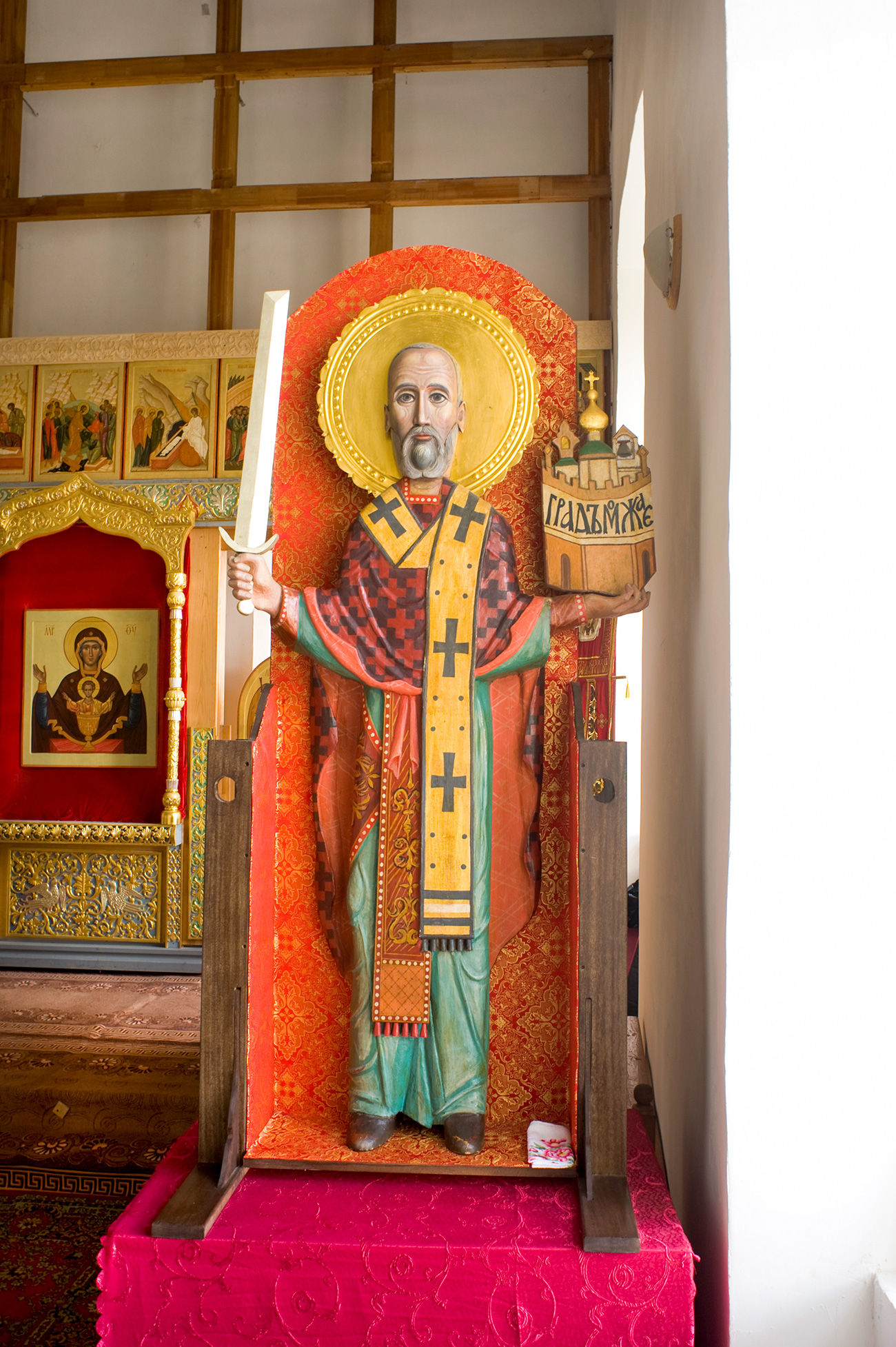 Cathedral of St. Nicholas. Interior with wooden statue of St. Nicholas of Mozhaisk. Aug. 21, 2012. / Photo: William Brumfield
Cathedral of St. Nicholas. Interior with wooden statue of St. Nicholas of Mozhaisk. Aug. 21, 2012. / Photo: William Brumfield
After the Soviets came to power, the cathedral was pilfered and some of its most valuable objects taken to museums. It was closed for worship in 1933, and the iron fence visible in Prokudin-Gorsky’s photograph was demolished. During the prolonged Battle of Moscow during World War II, the cathedral was severely damaged before Mozhaisk was retaken by the Red Army in late January 1942. In particular, the rotunda and supporting roof were destroyed.
After the war, the St. Nicholas Cathedral was conserved and, in the early 1960s, partially restored, but as my photographs show, the technically challenging rotunda was not rebuilt. The interior housed a workshop for knitted goods until the 1980s, when the structure was placed under the protection of the Mozhaisk Local History Museum, at that time part of the Borodino Military History Museum. The structure was returned to the Russian Orthodox Church in 1994 and resumed its function as the town cathedral. Restoration of the interior of this national landmark continues to this day.
 Cathedral of St. Nicholas. South view. July 5, 2015. / Photo: William Brumfield
Cathedral of St. Nicholas. South view. July 5, 2015. / Photo: William Brumfield
In the early 20th century the Russian photographer Sergei Prokudin-Gorsky invented a complex process for color photography. Between 1903 and 1916 he traveled through the Russian Empire and took over 2,000 photographs with the new process, which involved three exposures on a glass plate. In August 1918 he left Russia with a large part of his collection of glass negatives and ultimately resettled in France. After his death in Paris in 1944, his heirs sold his collection to the Library of Congress. In the early 21st century the Library digitized the Prokudin-Gorsky Collection and made it freely available to the global public. A number of Russian websites now have versions of the collection. In 1986 the architectural historian and photographer William Brumfield organized the first exhibit of Prokudin-Gorsky photographs at the Library of Congress. Over a period of work in Russia beginning in 1970, Brumfield has photographed most of the sites visited by Prokudin-Gorsky. This series of articles will juxtapose Prokudin-Gorsky’s views of architectural monuments with photographs taken by Brumfield decades later.
If using any of Russia Beyond's content, partly or in full, always provide an active hyperlink to the original material.
Subscribe
to our newsletter!
Get the week's best stories straight to your inbox